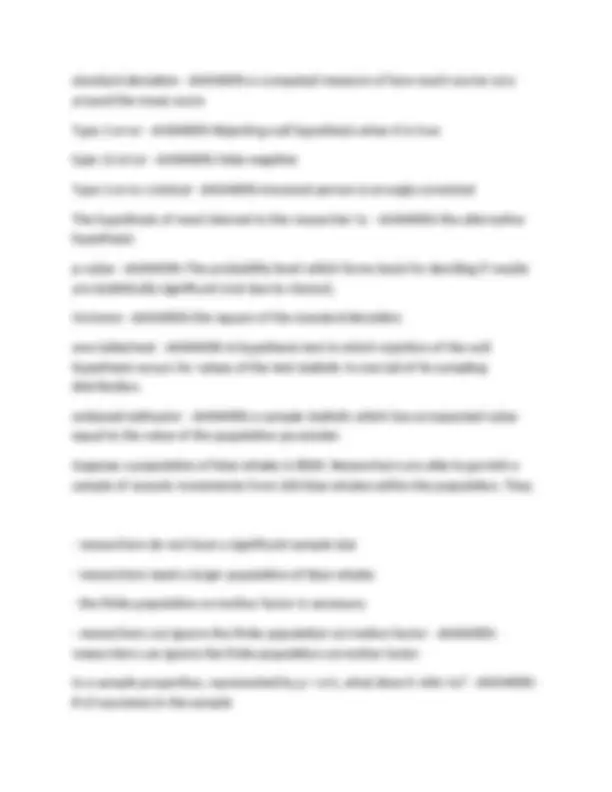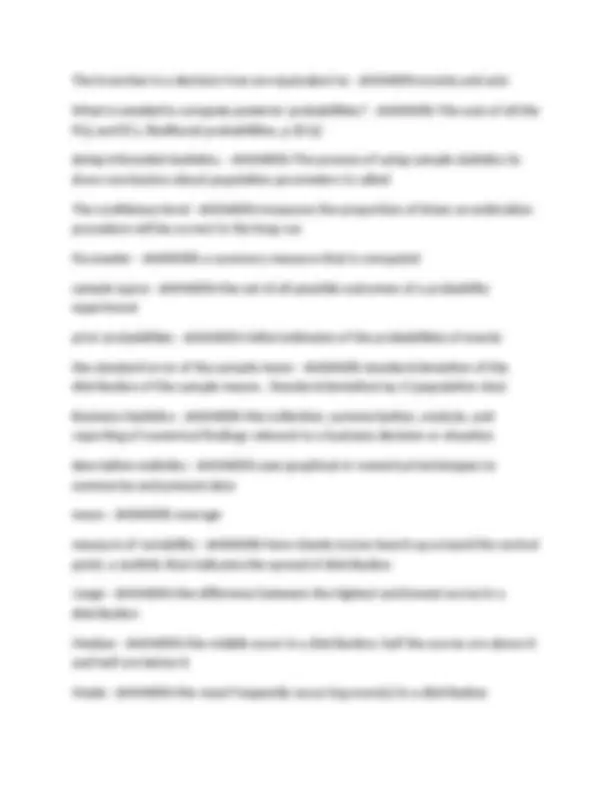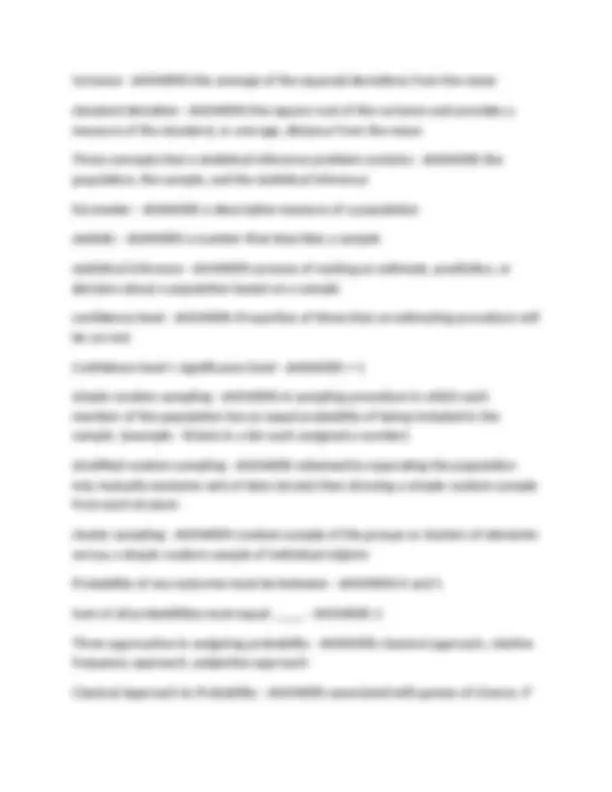





Study with the several resources on Docsity

Earn points by helping other students or get them with a premium plan


Prepare for your exams
Study with the several resources on Docsity

Earn points to download
Earn points by helping other students or get them with a premium plan
Community
Ask the community for help and clear up your study doubts
Discover the best universities in your country according to Docsity users
Free resources
Download our free guides on studying techniques, anxiety management strategies, and thesis advice from Docsity tutors
Quantitative Research Techniques + Statistics – Peregrine 69 questions with complete solutions 2025 Graded A+ Pass. Quantitative Research Techniques + Statistics – Peregrine 69 questions with complete solutions 2025 Graded A+ Pass.
Typology: Exams
1 / 6

This page cannot be seen from the preview
Don't miss anything!




A company developed a smartphone whose average lifetime is unknown. In order to estimate the average, 200 smartphones are randomly selected from a large production line and tested; their average is found to be 5 years. The 200 smartphones represent: - ANSWERS-a sample Significance level - ANSWERS-Measures the reliability of a statistical inference inferential statistics - ANSWERS-Process of using sample statistics (mathematics) to draw conclusions about population parameters mutually exclusive - ANSWERS-Events that cannot occur at the same time. sampling error - ANSWERS-the difference between the results of random samples taken at the same time non-sampling error - ANSWERS-occurs when the sample data are incorrectly collected, recorded, or analyzed. Three types of errors: data acquisition errors, non-response errors (or bias), selection bias Design of a good survey components - ANSWERS-short survey, short/simple questions, start with demographic questions, ues dichtomous (yes-no) and multiple choice Direct observation - ANSWERS-example: counts backpacks on campus for a day stratified random sample - ANSWERS-a sample from selected subgroups of the target population in which everyone in those subgroups has an equal chance of being included in the research example: The manager of a customer service division wants to know if the customers in the past 12 months are satisfied with their purchase of CD's. There are four types of CD's.
Joint Probability - ANSWERS-the probability of the intersection of two events Union of two events - ANSWERS-The union of events A and B is the event containing all sample points that are in A or B or both Marginal Probability - ANSWERS-the probability of a single event without consideration of any other event Conditional Probability - ANSWERS-the likelihood that a target behavior will occur in a given circumstance Bayes Law - ANSWERS-calculates posterior probability exhaustive - ANSWERS-including everything possible; very thorough or complete Central Limit Theorem (CLT) - ANSWERS-The name of the theorem stating that the sampling distribution of a statistic (e.g. x ) is approximately normal whenever the sample is large and random. Allows us to draw conclusions about the population based on strictly sample data. sampling distribution of the mean - ANSWERS-1. the sampling distribution of the mean has a different mean from the original population
The branches in a decision tree are equivalent to - ANSWERS-events and acts What is needed to compute posterior probabilities? - ANSWERS-The sum of all the P(sj and li)'s, likelihood probabilities, p (li/sj) doing inferential statistics. - ANSWERS-The process of using sample statistics to draw conclusions about population parameters is called The confidence level - ANSWERS-measures the proportion of times an estimation procedure will be correct in the long run Parameter - ANSWERS-a summary measure that is computed sample space - ANSWERS-the set of all possible outcomes of a probability experiment prior probabilities - ANSWERS-initial estimates of the probabilities of events the standard error of the sample mean - ANSWERS-standard deviation of the distribution of the sample means , Standard deviation/sq rt (population size) Business Statistics - ANSWERS-the collection, summarization, analysis, and reporting of numerical findings relevant to a business decision or situation descriptive statistics - ANSWERS-uses graphical or numerical techniques to summarize and present data mean - ANSWERS-average measure of variability - ANSWERS-how closely scores bunch up around the central point; a statistic that indicates the spread of distribution range - ANSWERS-the difference between the highest and lowest scores in a distribution Median - ANSWERS-the middle score in a distribution; half the scores are above it and half are below it Mode - ANSWERS-the most frequently occurring score(s) in a distribution
Variance - ANSWERS-the average of the squared deviations from the mean standard deviation - ANSWERS-the square root of the variance and provides a measure of the standard, or average, distance from the mean Three concepts that a statistical inference problem contains - ANSWERS-the population, the sample, and the statistical inference Parameter - ANSWERS-a descriptive measure of a population statistic - ANSWERS-a number that describes a sample statistical inference - ANSWERS-process of making an estimate, prediction, or decision about a population based on a sample confidence level - ANSWERS-Proportion of times that an estimating procedure will be correct Confidence level + significance level - ANSWERS-= 1 simple random sampling - ANSWERS-A sampling procedure in which each member of the population has an equal probability of being included in the sample. (example - tickets in a bin each assigned a number) stratified random sampling - ANSWERS-obtained by separating the population into mutually exclusive sets of data (strata) then drawing a simple random sample from each stratum cluster sampling - ANSWERS-random sample of the groups or clusters of elements versus a simple random sample of individual objects Probability of any outcome must be between - ANSWERS-0 and 1 Sum of all probabilities must equal: ____ - ANSWERS- Three approaches to assigning probability - ANSWERS-classical approach, relative frequency approach, subjective approach Classical Approach to Probability - ANSWERS-associated with games of chance. If